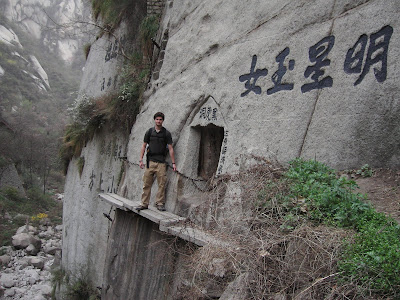From Phenom Penh it is nearly six hours by bus to Siem Reap, depending on which ticket you buy. Scalpers hawking budget-class fares usually lead to an uncomfortable and completely unreliable ride on a beat jalopy with no air-conditioning; if it doesn't break down the trek can take the better part of an entire day, crossing the Mekong basin. Our tuk-tuk driver warns us against this, and shows us to a bus agency that is only nominally more expensive (the difference of $10 U.S.) and by all accounts legitimate. The ride is long and at most stretches unpaved, though it is the only road operating between the two cities. For the first few hours, the landscape is like a scene from Apocalypse Now – a starving portrait of an undeveloped and unchanged countryside, dotted by slimy jade-colored water holes, and the occassional sugarpalm bent beneath the weight of a white sun.
Upon arriving in Siem Reap, that same star becomes a shimmering red orb that melts into the treetops, and at dusk we check in to a hostel called “The Riverside.” Its namesake turns out to be a stagnant, trash-filled creek that looks thick as sludge. Before even turning my room key into the lock, the entire town loses power, and the activity in my hostel is silenced by the mantle of darkness. I fumble around, ditching my backpack before finding the manager who offers a single candle – their backup generator isn't working, either. Outside I can hear the sputtering buzz of mopeds, and above the traffic, a troupe of monkies yelping in the distance. We meet two girls in the lobby who introduce themselves as backpackers as well, both from London. Together they've been walking and bussing through Indo-China, which I admire. They tell us about having recently crossed the Thai-Malaysian border – just a week earlier a bomb had detonated at the checkpoint they passed. We continue chatting for some time in the candlelight, and they recommend a few restaurants to try in town.
I get up at 5:30 the next morning to catch the sunrise over Angkor Wat. It is a vast and ancient complex that marked the spiritual and secular heart of the Khmer empire, founded over a millenia ago. For years it was lost to the jungle until being effectively 'discovered' to the Western World by French colonists in the 19th century, having heard rumors of an ancient city, one built by gods or giants.
That morning at the temple summit I meet a Canadian girl named Genevieve, who at 23 has taken time off from her job as tour-guide and concierge in Peru to backpack Southeast-Asia for a year. She is fluent in French, Spanish and English, and we decide to keep each other company for the time and explore the ruins together.
The following photos were taken over the course of my day hiking Angkor Wat and the adjacent temple sites, from dawn to sunset.

Ta Prohm doorway.

The reflecting pool, Angkor Wat.

Ta Prohm temple.

Temple, Angkor Wat.

Temple at Bayon.

Bas relief detail.

Bayon.
 My final trek, the north face.
My final trek, the north face. Everest at dawn.
Everest at dawn. My first view of Everest.
My first view of Everest. A Shegari nomad.
A Shegari nomad. A monk in Gyantse monastery.
A monk in Gyantse monastery. Yak herders, Holy Nam'tso Lake.
Yak herders, Holy Nam'tso Lake. A reflecting pool, Holy Nam'tso Lake.
A reflecting pool, Holy Nam'tso Lake. Desert crows over beat prayer flags.
Desert crows over beat prayer flags. The palace gardens, Potala, Lhasa.
The palace gardens, Potala, Lhasa.




























